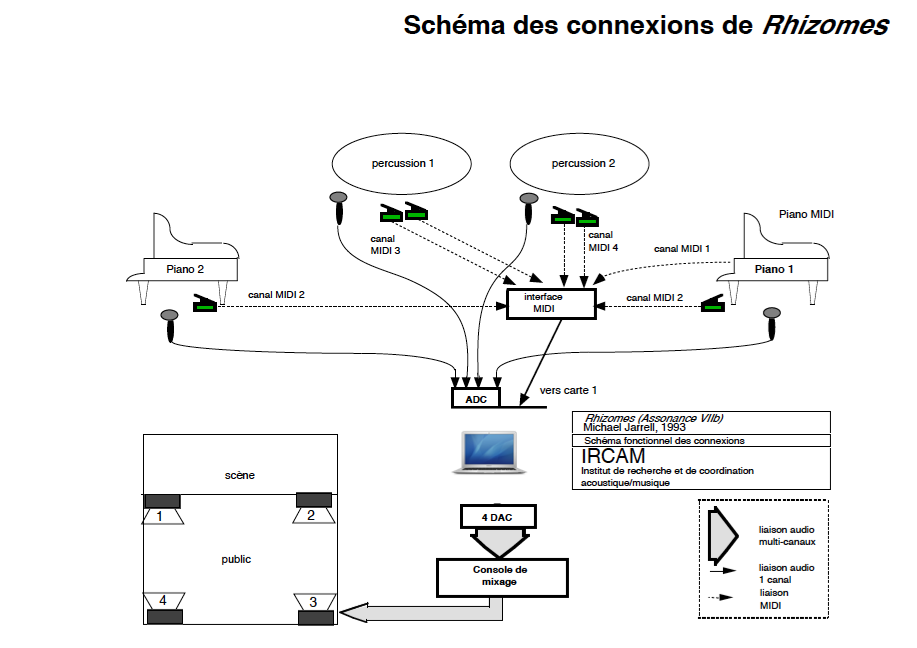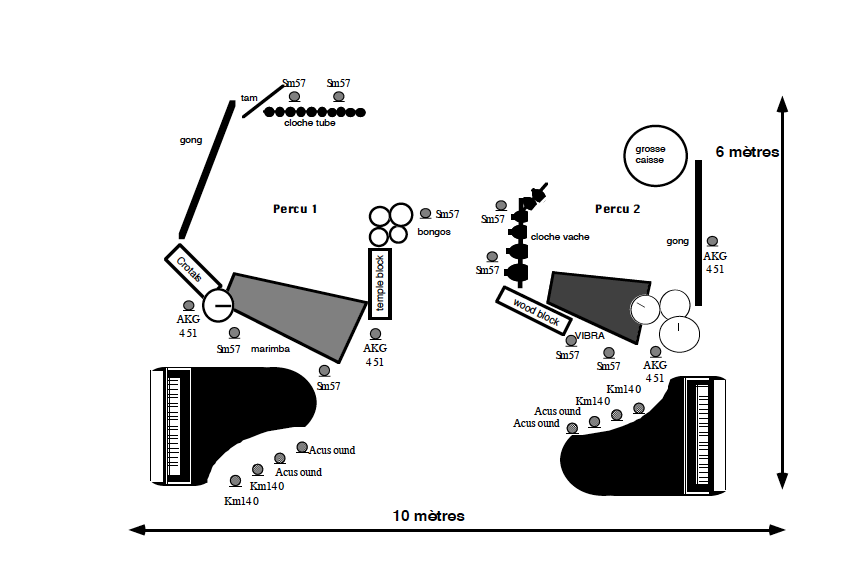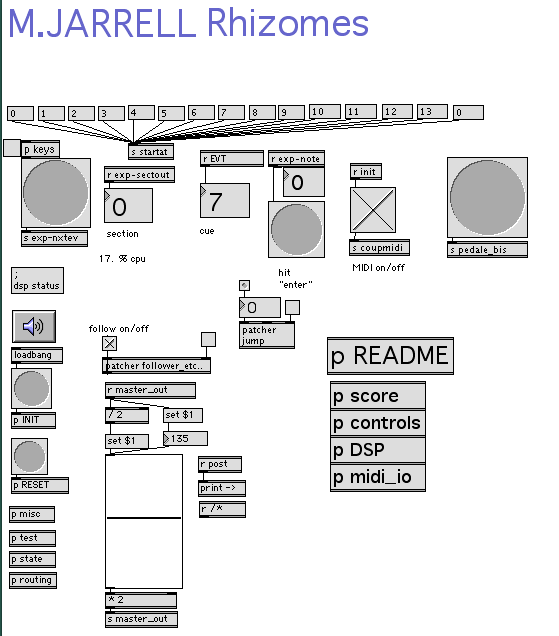Table of contents
Performance date: 3 juin 2004
Documentation date: 3 juin 2004
Version state
Valid
Validation date: 2 mai 2018
Executions dates of this version
- 3 juin 2004,
Version documentalist
- lemouton (Serge.Lemouton@ircam.fr)
Version realisation
- Serge Lemouton (Computer Music Designer)
Version length
15 mnUpgrade Motivation
first execution on a Macintosh (Power PC only)
Comment
Au conservatoire de Genève :
le 23 juin 2004 l'ensemble "Face à face" a interprété, dans le programme de leur examen postgrade de musique d'ensemble, une version de "Rhizomes" de M.Jarrell et tout c'est très bien passé; nous avons solutionné tous les problèmes, et la pièce c'est bien déroulée avec un suivi minutieux des évènements dans Max.
Other version(s)
Detailed staff
- 2 pianos, 2 percussionnistes
Electronic equipment list
Computer Music Equipment
-
1 Macintosh G4 - Apple Desktops
(Apple)
G4 - 860 Mhz under Mac OS9 -
1 Max/MSP - Max
(Cycling74)
version 4.3 -
1 Sound Board - Sound Board
4 ins - 4 outs -
6 Footswitch / Sustain Pedal - Footswitch / Sustain Pedal
one for each piano and two for each percussionist -
1 MIDI Piano Interface KS1 - MIDI Converter
(Gulbransen)
for piano 1 (coté cour) -
1 AtomicPro - MIDI Converter
(Ircam)
to convert the switch pedal to midi controllers -
1 Midi interface - MIDI Interfaces
midi interface
Audio Equipment
-
4 contact microphone - Contact Microphones
(Accusound)
2 for each piano -
4 Loudspeaker - Loudspeakers
Work related information
Premiere
- 17 mai 1993, Paris, Centre Georges-Pompidou
Publisher :
- Lemoine
Realisation
- Thomas Hummel
- Zack Settel
Work length
- 15 mn
Event
- concert Ictus - jeu 03 Jui 2004 - Espace de Projection - Agora2004
Useful links on Brahms
- Rhizomes Assonance VIIb, pour deux pianos, deux percussionnistes et dispositif électroacoustique (1993), 15mn
- Michael Jarrell
| File | Author(s) | Comment | |
|---|---|---|---|
| Download [143,7 Kio] | Document original Ircam documentation | Marc Battier | doc for the original ISPW-based version (now obsolete) |
| Download [96,6 Kio] | Patch Rhizomes-MacSetup.png | ||
| Download [9,7 Mio] | Patch max patch | serge Lemouton | |
| Download [31,6 Kio] | Patch RhizomesMacMainPatch.png |
Instructions
Audio, Loudspeaker and Midi setup

Stage setup

Software installation
Copy the RhizomesJuin2004 folder on your hard disk.
Start MaxMsp version 4.
Set the Max File Preferences to the folders :
- Rlib
- Rsounds
Check the DSP Status :
- Max Scheduler in Overdrive ON
- Scheduler in Audio Interrupt ON
- Driver : ASIO Hammerfall
- Alt ASIO Mode
- io vs 512
- vs 64
- optimize off
Patch presentation

Midi setup and tests
To check the midi devices, open the midi_io patcher.
The Piano 1 should be on midi channel 1
- piano 1 footswitch : controller n.64, channel 1
- piano 2 footswitch : controller n.65, channel 1
- perc1 footswitches : both on controller n.64, channel 3
- perc2 footswitches : both on controller n.64, channel 4
These assignements can be adjusted in the midi_io patcher
Input Audio assignment
- piano1 : adc1
- piano2 : adc2
- perc1 : adc3
- perc2 : adc4
Performance Notes
The Macintosh audio outputs are sent to a good quality reverberation (with a RT of about 3 sec), the ouput of this reverberation unit send to all the speakers.
To play the piece
Open the RHIZOMES-TR03.pat patch with MaxMsp version 4.
Switch the DSP on.
Select the section 1 : you are ready, the musicians can start playing !
During the performance of Rhizomes, you should carefully follow the musical score and monitor the event sequencing as it can be necessary to resynchronize the score following system (in case of too many consecutive wrong notes from the musicians, for instance)
© IRCAM

This documentation is licensed under a Creative Commons Attribution-NonCommercial-NoDerivatives 4.0 International License.
Program note
« Rhizome, écrit Michael Jarrell, est un terme de botanique. C'est l'appellation d'une tige souterraine qui s'allonge en poussant soit des rameaux, soit des feuilles à l'une de ses extrémités, tandis qu'elle se détruit par l'autre. Comme l'étymologie l'indique, il s'agit d'une racine. »
[work:9504][Trei II] pour soprano et cinq instruments (1982-1983) et [work:9478][Assonance VII] pour un percussionniste (1992) peuvent être considérées comme les deux « racines souterraines » de Rhizomes. Ces deux œuvres explorent certaines possibilités de la superposition de périodes ou de tempi différents — possibilités que Rhizomes intègre à des « cycles de développements » continus : la simple répétition d'une note peut donner naissance à des figurations rapides, à des trémolos, à des trilles, à un son tenu, selon les embranchements que le compositeur emprunte, selon les « chemins » qu'il suit au sein des arborescences qui constituent une manière de « grammaire générative » pour la pièce.
Cette continuité mouvante se retrouve dans le travail du timbre : ainsi, la préparation de l'un des deux pianos pourra créer un « pont » vers la sonorité du wood-block. Et de fait tout le projet de Rhizomes pourrait être considéré comme un nouveau regard porté sur cette interrogation qui était au cœur de Trei II : comment intégrer la percussion, cet « élément perturbateur », au sein de l'univers tempéré ?
Peter Szendy.
Version documentation creation date: None, update date: 6 mai 2021 15:10